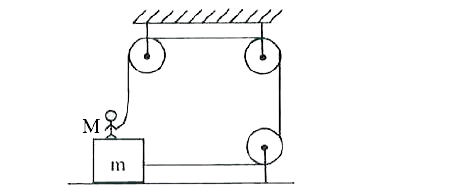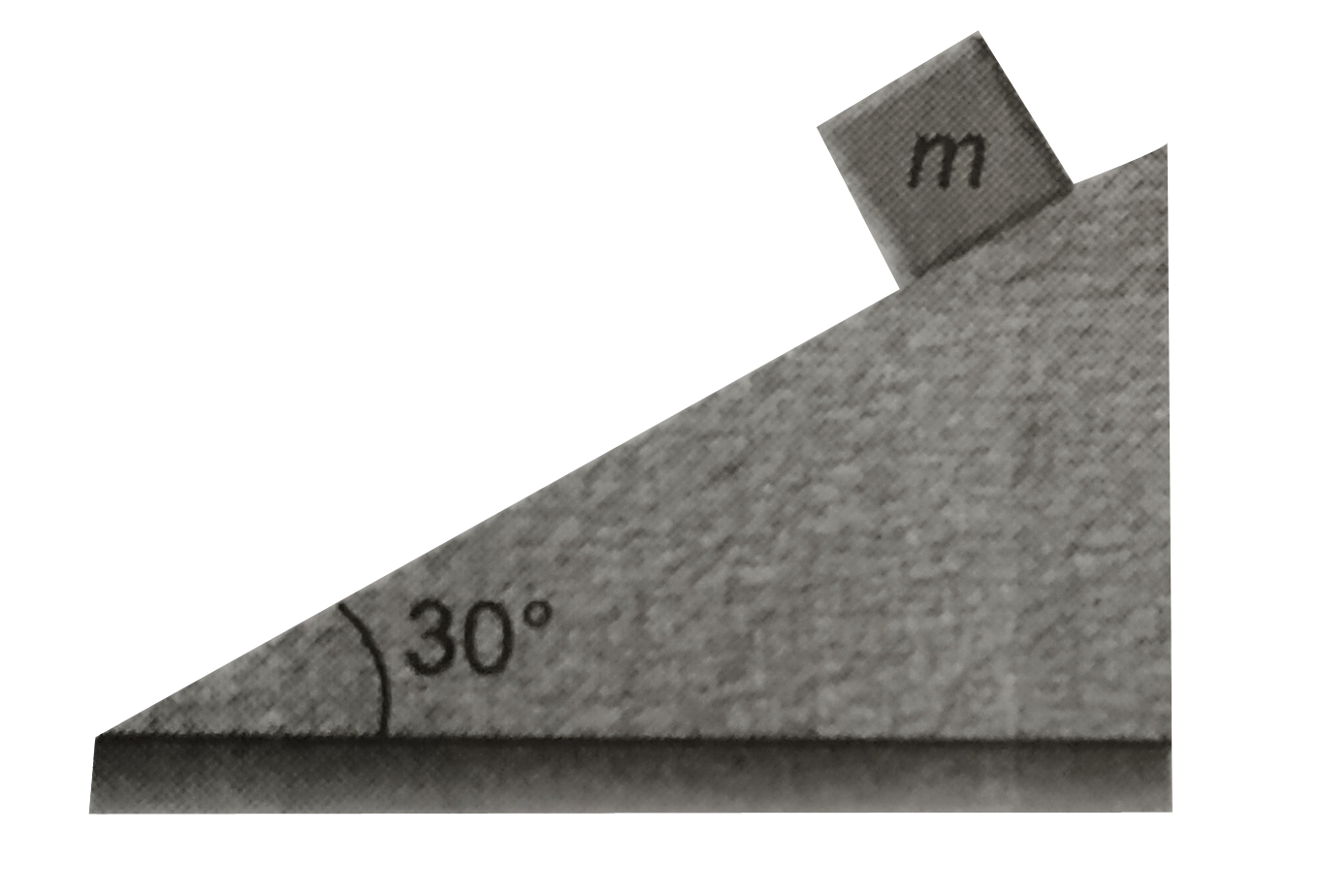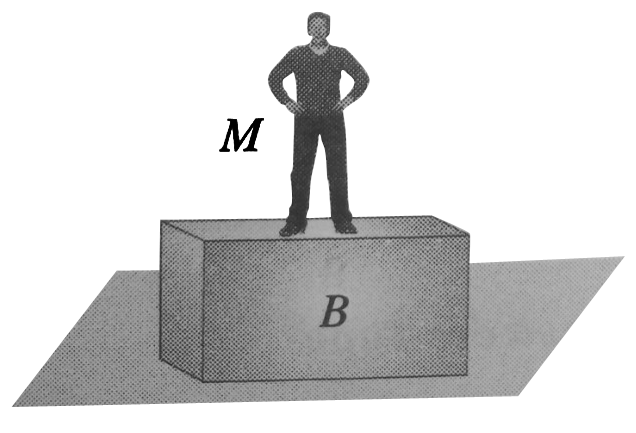A man pulls a block heavier than himself with a light rope. The coefficient of friction is the same between the man and the ground and between the block and the ground. a The block will not move unless the man also moves. b The man can move even when the block is stationary. c If both move the acceleration of the man is greater than the acceleration of the block. d None of the above assertions is correct.
Correct Answer is: a b & cLet T = tension in the rope. Force T acts on both. The limiting force of friction is larger for the block than for the man. Each body will move when T exceeds the force of friction.
Related Solutions
A man pulls a block heavier than himself with a lioght rope. The coefficient if friction is the same between the man and the ground, and between the block and the ground.
View SolutionA man pulls a block of mass equal to himself with a light string .The coefficient of friction between the man and the floor is greater than that between the block and the floor
View SolutionA man pulls a block of mass equal to himself with a light string .The coefficient of friction between the man and the floor is greater than that between the block and the floor
View SolutionFigure shows a man pulling on a string attached to a block kept on a rough block surface. Man is heavier than block. Coefficient of friction is same for both block and man. Subscripts R, B and M denote rope block and man respectively, taking string to be light. Mark the correct statement(s).
View Solutionचित्र में एक मनुष्य एक रस्सी के सहारे M द्रव्यमान के एक गुटके को निचे उतार रहा है । वह रस्सी इस तरह जाने देता है कि गुटके का त्वरण निचे की ओर a होता है ।
रस्सी के निचले सिरे पर उसमें तनाव निकालें ।
View SolutionMas of man is 'm' There is no friction between man and black But is coefficient of friction between block and floor.

Maximum force that the man can exert on the rope so that the block does not slip on floor
View SolutionFor the arrangement shown in the figure the coefficient of friction between the two blocks is mu . If both the blocks are identical and moving ,then the acceleration of each block is
View SolutionFor the arrangement shown in the figure the coefficient of friction between the two blocks is mu . If both the blocks are identical and moving ,then the acceleration of each block is
View SolutionA block of mass 5 kg is placed on bus moving with acceleration .pseudo force acting on block as seen by a man on ground is -
View SolutionA man wants to slide down a block of mass which is kept on a fixed inclined plane of inclination as shown in the figure .Initially the block is not sliding .
To just start sliding the man pushed the block down the inclined with a force . Now , the block starts accelerating. To move it downwards with conatant speed the man starts pulling the block with same force. Surface are such that ratio of maximum static friction to kinetic friction is Now, answer the following questions.

If the man continues pushing the block by force its acceleration would be
View SolutionA man wants to slide down a block of mass which is kept on a fixed inclined plane of inclination as shown in the figure .Initially the block is not sliding .
To just start sliding the man pushed the block down the inclined with a force . Now , the block starts accelerating. To move it downwards with conatant speed the man starts pulling the block with same force. Surface are such that ratio of maximum static friction to kinetic friction is Now, answer the following questions.

If the man continues pushing the block by force its acceleration would be
View Solution

A man wants to slide down a block of mass m which is kept on a fixed inclined plane of inclination as shown in figure initially, the block is not sliding. To just start sliding the man pushes the block down the inclined with a force F. Now the block starts accelerating. To move it downwards with constant speed, the man starts pulling the block with same force. Surfaces are such that ratio of maximum static friction to kinetic friction is 2. Now, answer the following questions.
If man continues pushing the block by force F, its acceleration would be
View SolutionConsider a large block placed on a smooth horizontal surface, with a man standing at one end of the block. The man walks to the other end, relative to the block. The distances (absolute) moved by the man and the block are :
View SolutionAs shown in the figure, M is a man of mass 60 kg standing on a block of mass 40 kg kept on ground. The co-efficient of friction between the feet of the man and the block is 0.3 and that between B and the ground is 0.1. If the man accelerates with an acceleration 2(m)/(s^2) in the forward direction, then,
View Solution
As shown in the figure, M is a man of mass 60 kg standing on a block of mass 40 kg kept on ground. The co-efficient of friction between the feet of the man and the block is 0.3 and that between B and the ground is 0.1. If the man accelerates with an acceleration in the forward direction, then,
View SolutionFind the acceleration of block B as shown in fig. (a) and (b) relative to block A and relative to ground if block A is moving toward right with acceleration a.
View SolutionFind the acceleration of block B as shown in fig. (a) and (b) relative to block A and relative to ground if block A is moving toward right with acceleration a.
View SolutionA man pulls out a block of mass m from the depth d with help of a light string. If acceleration of the block is then the work done by the string on the block will be
View SolutionA man pulls out a block of mass m from the depth d with help of a light string. If acceleration of the block is then the work done by the string on the block will be
View SolutionA man wants to slide down a block of mass which is kept on a fixed inclined plane of inclination as shown in the figure .Initially the block is not sliding .
To just start sliding the man pushed the block down the inclined with a force . Now , the block starts accelerating. To move it downwards with conatant speed the man starts pulling the block with same force. Surface are such that ratio of maximum static friction to kinetic friction is Now, answer the following questions.

What minimum force is required to move it up the incline with constant speed?
View Solution